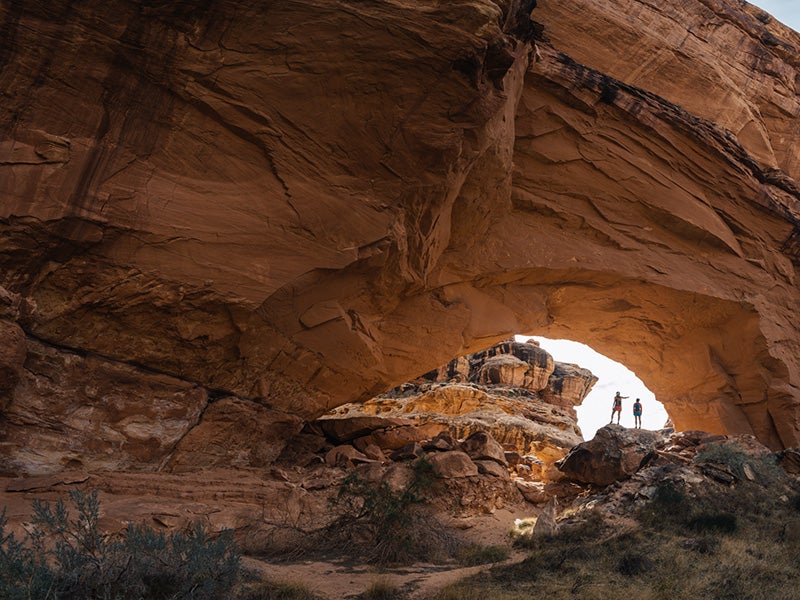Defending Bears Ears
This national monument — and the more than one hundred others — are part of what make this land great.

Former President Trump attemted to eliminate more than one million acres from Bears Ears National Monument.
In part of the largest rollback of federal land protection in U.S. history, former President Trump gutted Utah’s Bears Ears National Monument — home to ancient cliff dwellings, Native American cultural sites, and iconic wildlife — by 85% in 2017.
The move disregarded both our national heritage and the law.
Former President Trump attemted to eliminate more than one million acres from Bears Ears National Monument.
Just days after the decision, Earthjustice filed a lawsuit, representing a coalition of conservation groups in the suit. The Natural Resources Defense Council and Southern Utah Wilderness Alliance were co-plaintiffs in the case, represented by counsel from those organizations.
Our Clients The Wilderness Society, National Parks Conservation Association, Sierra Club, Grand Canyon Trust, Defenders of Wildlife, Great Old Broads for Wilderness, Western Watersheds Project, WildEarth Guardians, Center for Biological Diversity
After a months-long review, the Biden administration fully restored protections to Bears Ears on Oct. 8, 2021. Our cases and the threat of further litigation helped to stave off some of the worst damage of industrial activities.
President Obama designated the Bears Ears National Monument after years of advocacy from a historic partnership between the Hopi, Navajo, Ute Indian Tribe, Ute Mountain Ute and Zuni governments, along with archaeological, conservation, and recreation voices.
“What is sacred cannot be reversed.”
– James Adakai President of the Navajo’s Oljato Chapter and member of the Bears Ears Commission
The monument designation included a historic plan for co-management of this unique landscape by federal agencies and the five tribes with sacred cultural interests in the lands.
Former President Trump’s move would have unraveled protections for this unique area, leaving it vulnerable to oil and uranium interests and looters who rob sacred sites.
By restoring protections to Bears Ears, the Biden administration ensures the preservation of thousands of years of Tribal history and sacred sites.
These mesas, cliffs, and canyons in Utah are home to over 100,000 Native American archaeological and cultural sites, with some dating back to 12,000 B.C.E. Tribes continue to visit these lands to hold ceremonies and to connect with their ancestors.
Bears, bighorn sheep, and mountain lions thrive in this striking wilderness. Two buttes jutting thousands of feet above canyon lands form the region’s namesake, “Bears Ears.”
To safeguard Bears Ears, President Obama used the Antiquities Act, a century-old law established to protect America’s iconic lands and cultural heritage.
The Antiquities Act has been embraced by 16 presidents from Teddy Roosevelt to President Obama to protect national treasures such as the Grand Canyon, the Misty Fjords National Monument in Alaska’s Tongass National Forest, the Giant Sequoia National Monument in Northern California and the Statue of Liberty.
Presidents do not have the legal authority to undo monument protections under the Antiquities Act. The Constitution reserves for Congress the right to decide what happens on federal land. Though the Antiquities Act grants presidents the power to designate national monuments, it says nothing about abolishing them.
Citadel Ruins, Cedar Mesa was among the more than one million acres of wildlands and rare archaelogical sites that the Trump presidential proclamation is attempted to eviscerate.
Moki Dugway was among the more than one million acres of wildlands and rare archaelogical sites that the presidential proclamation attempted to eviscerate.
Dark Canyon Wilderness was among the more than one million acres of wildlands and rare archaelogical sites that the Trump proclamation attempted to eviscerate.
Grand Gulch was among the more than one million acres of wildlands and rare archaelogical sites that the Trump proclamation attempted to eviscerate.
In 1938, when President Franklin Roosevelt considered removing the national monument status of crumbling Castle Pinckney, his attorney general advised him that it would be illegal.
But Trump chose to break the law to benefit industry.
Bears Ears National Monument — and the more than one hundred other national monuments — are part of what make this land great.